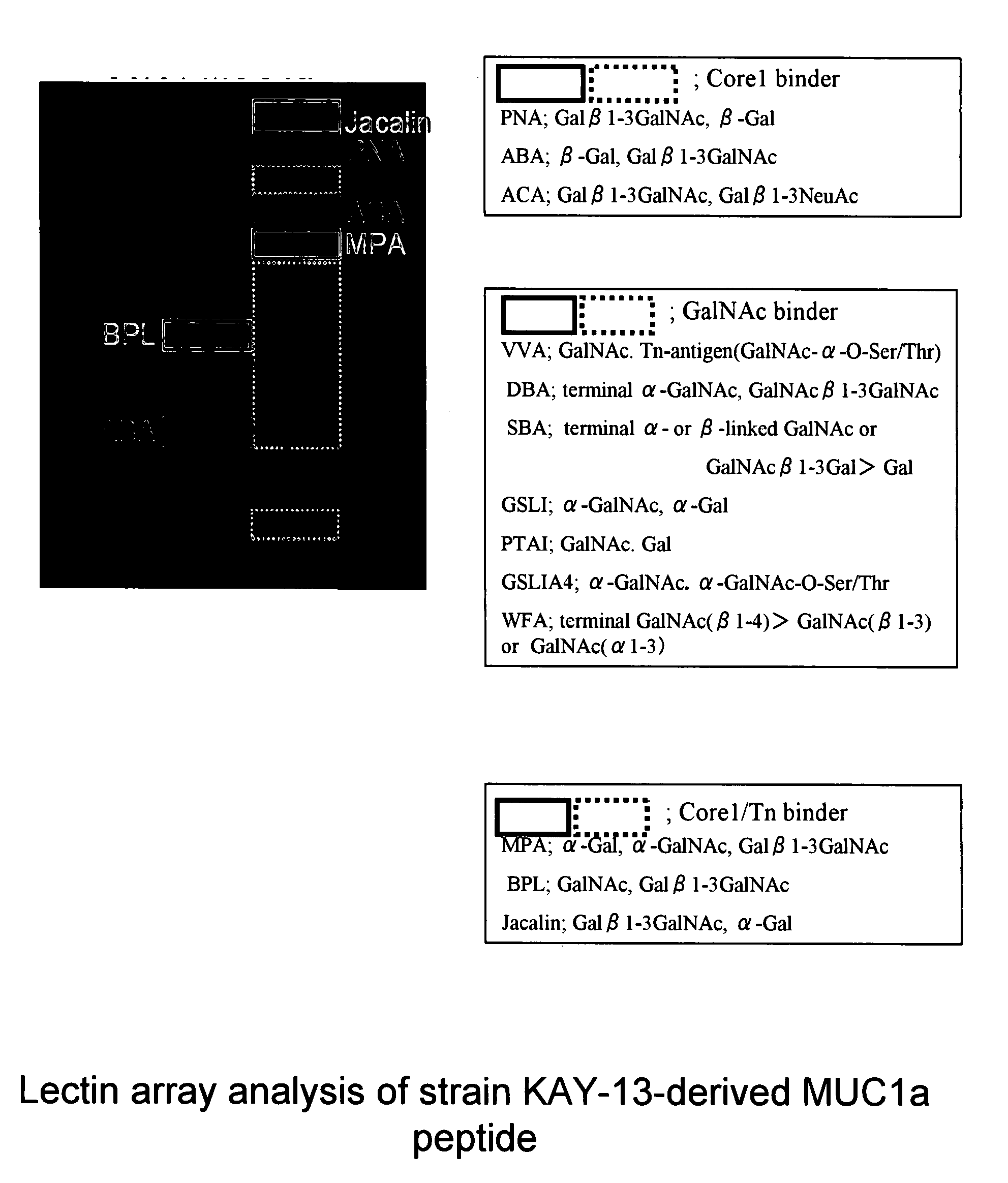Method for producing a mucin-type glycoprotein
a glycoprotein and mucin technology, applied in the field of yeast transformants, can solve the problems of low possibility of reproducing the higher-order structure of the protein itself, the method for chemically synthesizing a high molecular protein has not been established, and the production method is extremely expensive. achieve the effect of efficient and inexpensive production
- Summary
- Abstract
- Description
- Claims
- Application Information
AI Technical Summary
Benefits of technology
Problems solved by technology
Method used
Image
Examples
example 1
Production of Mucin-Type Glycopeptide-Producing Yeast Strains Using S. cerevisiae
[0112]GalE gene derived from Bacillus subtilis is present on the genome of Bacillus subtilis, and its cDNA sequence has been deposited in the public database GenBank under the Accession No. P55180. First, the full-length cDNA of the GalE gene was amplified by PCR using the genome DNA of the Bacillus subtilis strain 168 as a template and primer A (SEQ ID NO: 11) and primer B (SEQ ID NO: 12) as primers.
SEQ ID NO: 11:GGAATTCATGTTAATTAACGCAATACTTGTTACTSEQ ID NO: 12:GCTCTAGATTATTCCGCACTCTTATA
The resultant PCR product was cleaved at the EcoRI and XbaI sites and incorporated into the EcoRI / XbaI site of plasmid pBluescript II(SK−) (from Stratagene), a plasmid for cloning in E. coli, to construct plasmid pBluescript II(SK−)-GalE. Then, a PaCI site-containing DNA sequence for expressing the myc antigen was prepared by PCR using primer C (SEQ ID NO: 13) and primer D (SEQ ID NO: 14) and cleaved at the PacI site. S...
example 2
Introduction of the MUC1a Peptide Gene into Mucin-Type Glycopeptide-Producing S. cerevisiae Strains and the Production of the Peptide
[0120]The MUC1 gene is located in the human chromosome 1, and the MUC1a gene has a nucleotide sequence (nucleotide 253 to 288 in SEQ ID NO: 7) derived from the internal repeat sequence of the MUC1 gene. The MUC1a gene was synthesized by PCR using primer M (SEQ ID NO: 23) and primer N (SEQ ID NO: 24).
SEQ ID NO: 23:CGGGATCCGGTCTAGATAAAAGAGCTCATGGTGTTACTTCTGCTCCAGACACTAGSEQ ID NO: 24:ACTTCTGCTCCAGACACTAGACATCACCATCACCATCACTAATCTAGAGGATCCCG
[0121]Here, an amino acid sequence (SEQ ID NO: 8) was designed so that a His6 tag for purification was fused to the 3′ region of the MUC1a gene. The PCR product was cleaved with XbaI and incorporated into the XbaI site of plasmid YEp352GAPII-α-factor (Abe et al, Glycobiology, 13: 87-95 (2003)), a plasmid for expression in yeast, containing the α-factor sequence as a signal sequence for external secretion, to prepare YEp3...
example 3
Confirmation of Generation of UDP-Gal and UDP-GalNAc in a Mucin-Type Glycopeptide-Producing S. cerevisiae Strain
[0128]To confirm the generation of UDP-Gal and UDP-GalNAc in the S. cerevisiae strains KAY-1 and W303-1A, the analysis of the UDP-sugars was carried out by reversed-phase HPLC. The column used was Cosmosil C18 (4.6×250 mm: from Nacalai Tesque), and the solvent used was a 100 mM potassium dihydrogen phosphate buffer (pH 6.2) containing 2 mM tetrabutylammonium phosphate. The column was equilibrated by running the solvent in advance at a flow rate of 0.6 ml / min., into which a sample was then injected for analysis. The detection was carried out using a UV detector (detection wavelength: 262 nm). The results are shown in FIG. 3. A peak not observed for the strain W303-1A as a control, i.e. a peak corresponding to UDP-GalNAc around 27.5 minutes was seen for the strain KAY-1. A peak corresponding to UDP-Gal was also seen around 14 minutes for the strain KAY-1 while a peak corresp...
PUM
 Login to View More
Login to View More Abstract
Description
Claims
Application Information
 Login to View More
Login to View More - R&D
- Intellectual Property
- Life Sciences
- Materials
- Tech Scout
- Unparalleled Data Quality
- Higher Quality Content
- 60% Fewer Hallucinations
Browse by: Latest US Patents, China's latest patents, Technical Efficacy Thesaurus, Application Domain, Technology Topic, Popular Technical Reports.
© 2025 PatSnap. All rights reserved.Legal|Privacy policy|Modern Slavery Act Transparency Statement|Sitemap|About US| Contact US: help@patsnap.com



